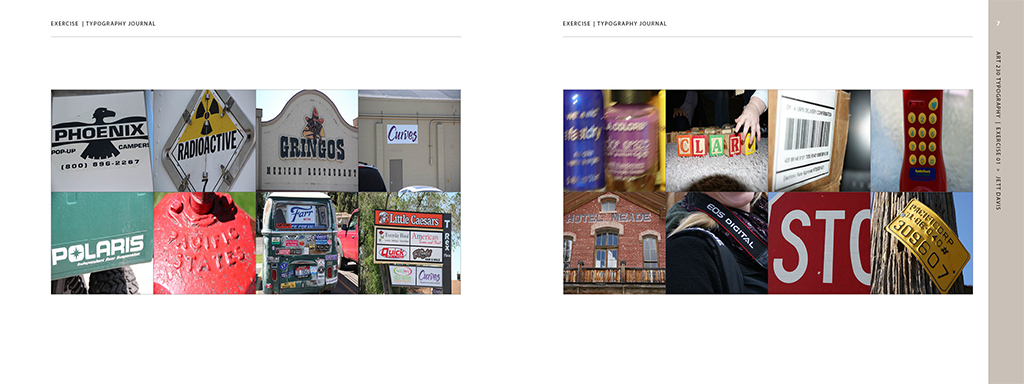Art 230 | Typography
Lesson 12
Project 03
Project 03 Step 02
Typogram: Computer Sketches
What are we doing?
Refine your initial typogram sketches into 4 digital sketches.
Why are we doing it?
The initial sketches need to be tested to see if the idea will translate into a great typogram. Some ideas seem great on paper but just don’t translate as a finished image. The reason we are doing 4 digital sketches is to provide several options refined enough to make sure they are going to work. Choosing the typogram that you think is most successful exercises your ability to make design choices.
How are we going to do it?
We will use the computer with real fonts to make mock-ups of the 4 best ideas. In Adobe Illustrator create an 11 x 8.5 wide art board. Place the typogram centered side to side and top to bottom with a bit more space at the bottom.
- Place each finished sketch into the boxes provided in the workbook.
- Mark the best sketch.
- Export workbook page as a jpeg.
- Create a blog post, including the jpeg of your best idea.
Process Blog Post
After you have completed all of the steps listed above for this lesson, you are ready to complete your process blog post. Blogposts should be structured like a presentation with a beginning, middle and end. Each step will involve it's own process and its own unique challenges and successes. Introduce the assignment, talk about what worked for you and what didn't, explain which of your solutions are working using design principles to back it up. If you have specific questions about how to move forward, you can ask them in the blogpost.
Please include the following in your blog post:
- Write a 200-word blog post that includes a JPEG image of page 5 exported from Adobe InDesign.
- Copy the text from the blog post and paste it into Project 03 workbook.
- Include paragraph breaks, subheads or other typographic elements to make the post visually accessible.
- The post should be designed and encourage a reader to engage.
- Include a featured image
Once the Process Blog Post is complete, submit a link to the post in I-Learn. To submit the link in I-Learn, click P3S2 link in the left navigation and then click on the Open button at the bottom of the I-Learn window.
After you have submitted your assignment in I-Learn, you will need to provide feedback to your team members in WordPress. Your feedback to team members will be on the following areas:
- Idea: Rate the uniqueness of the overall idea. Is it ordinary and expected or original and unexpected?
- 1–3 pts: unimaginative – confusing
- 4–6 pts: ok – great
- 7–10 pts: great – amazing
- Formal design choices: Rate how well the design principles are used.
- 1–3 pts: unimaginative – confusing
- 4–6 pts: ok – great
- 7–10 pts: great – amazing
- Typography: Rate font choice, size, kerning and spacing, add to the communication of the concept.
- 1–3 pts: not at all
- 4–6 pts: doesn’t help or hurt
- 7–10 pts: significantly adds to the overall communication
- Portfolio: Would you put this in your portfolio? Base this on the quality of the work, not whether it would be appropriate for your personal portfolio.
- 1–3 pts: no
- 4–6 pts: maybe with changes
- 7–10 pts: yes with no changes – absolutely
- Blog Post: Rate the quality of blog post.
- 1–3 pts: messy, unclear, major errors
- 4–6 pts: understandable, organized, rambling, spelling or grammar errors
- 7–10 pts: clear, thoughtful, engaging, free from errors
You should list the item, your rating, and any comments you had to help your team member improve. Your feedback on process blog posts will not be used as part of their grade but will help you to teach one another to improve their work.
Exercise
Type Journal | Part 2
What are we doing?
Complete 2 pages in your type journal.
(You should have 4 pages in total after completing this exercise.)

What we are going to do?
Using a camera, capture examples of typography in the world around you.
Why are we doing it?
Typography is about learning to see. Capturing glimpses of typography provides an opportunity for slowing down and seeing the typographic messages all around us.
How are we going to do it?
Use a camera to capture your typographic imagery. Do not use the Internet. Crop the images to fit into the squares in the Type Journal Exercise workbook. This project needs to be completed with 8 pages and a blog post within the next three weeks.
Reading
Reading 05
- Text | Thinking with Type by Ellen Lupton (2nd edition)
- Pages | 84–101